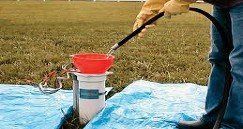Start your free evaluation today!
203.272.6017
1.800.628.6891
Refer A Friend for a $25 giftcard
HOW TO CHLORINATE YOUR WELL.
Reasons for chlorinating:
- The most common reason for this procedure is a bacteria problem, typically coliform bacteria. Another reason is to temporarily diminish an odor that may occur from time to time. Before beginning the process below make sure you do the follow prep work:
- Catch up on house hold laundry*
- Catch up on showers and bathing*
- Determine how much bleach* will be needed using this formula:
- If you have a drilled well – 1-gallon for every 100′.
- If you have a shallow well – 1-gallon for every 18″ of standing water
*Laundry and bathing cannot be done with a chlorinated well for at least 24 hours and in some cases, a couple of days. *Liquid non-scented household bleach is recommended. Purchasing a chlorine test kit at a pool/spa supply store in advance is a good idea
Chlorination:
- Open well cover
- Carefully pour bleach into well. If possible, coat the inner walls of the well with chlorine as you pour it in.
- If you have a cartridge filter, be sure to have a spare cartridge because the filter may clog quickly. If you have a bedded filter, softener, etc. put filter in bypass mode for now.
- Connect a garden hose from the bottom of the storage tank or outside faucet and run hose into the top of well and open the spigot fully.
- Allow circulation process to continue until chlorine is detected from hose. Once chlorine level is strong, wash down the inner walls of the well with the hose and shut off. Now replace cover on well. NOTE: A shallow well generally circulates within 1/2 hour, a deeper, drilled well can sometimes take a couple of hours. Once the hose is flowing chlorinated water, be careful, it may stain or damage clothing (cotton) and/or cause skin/eye irritation.
- If you have an electric water heater, it will take 10-15 minutes of running a couple of hot water faucets inside your house to remove the stored, un-chlorinated water with chlorinated water. All faucets, tubs, shower heads, toilets, laundry machines (set at low level warm water, no clothes), dishwashers, sprayers at kitchen sinks, outside faucets, and all plumbing in the house should be run one at a time until the chlorinated water is present and then shut down. The entire well, pumping and storage system, and all house plumbing are now treated. Advise all occupants as to the waters condition, and advise the only thing you can do is to flush toilets and maybe some general cleaning using gloves.
Discharging the chlorine:
24 hours after chlorinating start running a garden hose outside to some safe area. If you have a low production well, generally 15 minutes on, 45 minutes off, is a safe practice. As long as you are pumping water, you will not hurt your pump. Monitor the chlorine level and after some time, you should see the level decrease gradually as fresh water enters the well and dilutes the treated water in well. Continue discharging until no chlorine is detected. Chlorine removal is a slow process and may take a long time to remove. It is not uncommon to have chlorinated water for two or three days. Repeat step #6 of chlorinating process to replace the treated water with fresh water in the house plumbing after running water outside and chlorine residue is lowered. If applicable, install a new cartridge into the filter housing and/or switch softener from bypass to service mode. You may now safely return to normal household use of water. We recommend testing the water for bacteria (if this was the initial problem) before using the water for consumption. Also, follow-up testing is recommended to assure that a problem has not redeveloped.
Loss of pressure:
If low pressure results after treatment of well has been done, the following should be checked:
- Sediment filter in basement may be clogged.
- Screens on faucets may be clogged with sediment
If the water pressure on the gauge reads below 20 psi, shut off hose and let it sit for 30 minutes. If pressure does not come up, please call our office. If it reads above 25 psi and you have low pressure, check the first two options again, then call our office 1-800-628-6891.
Things to consider:
If bacteria is the problem, investigate the potential cause.
- Is the well cover cracked?
- Can surface water enter the well?
- Is the well cap a sanitary style?

